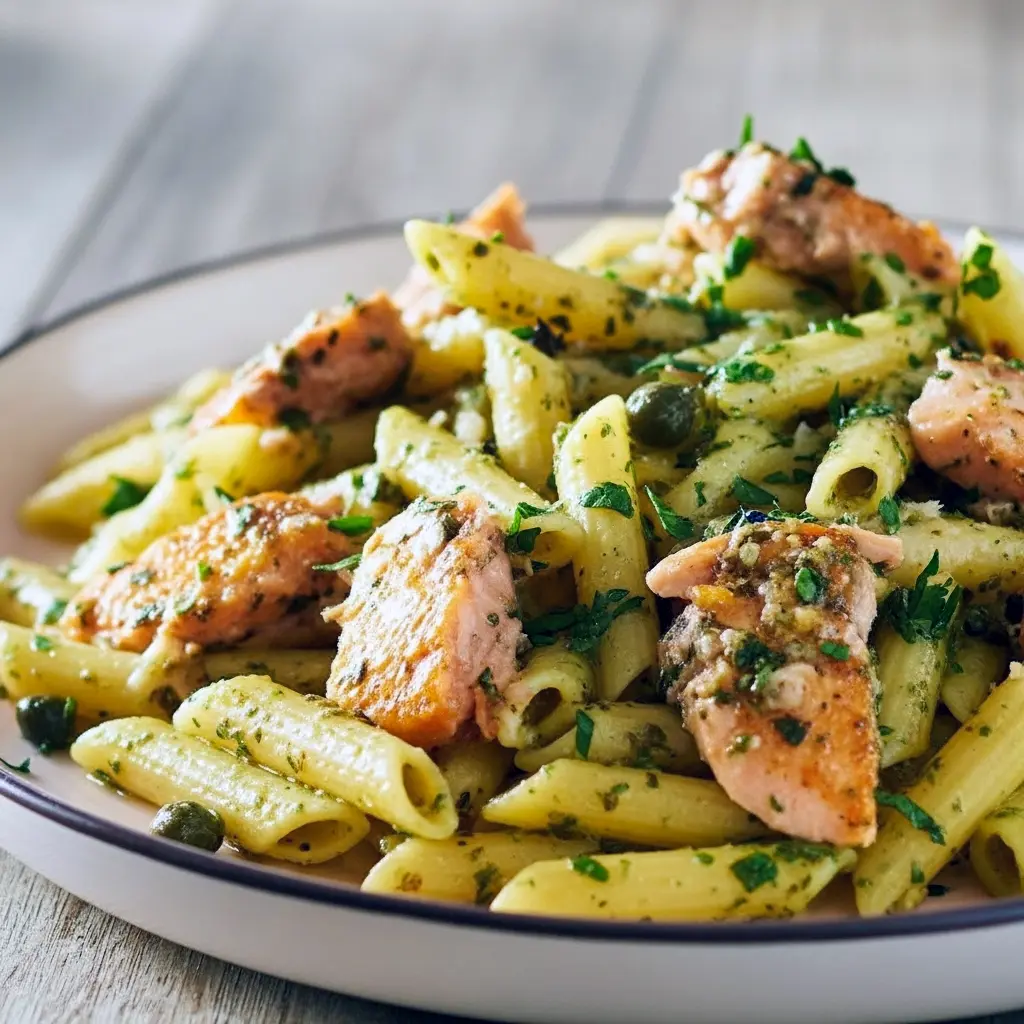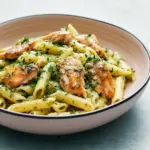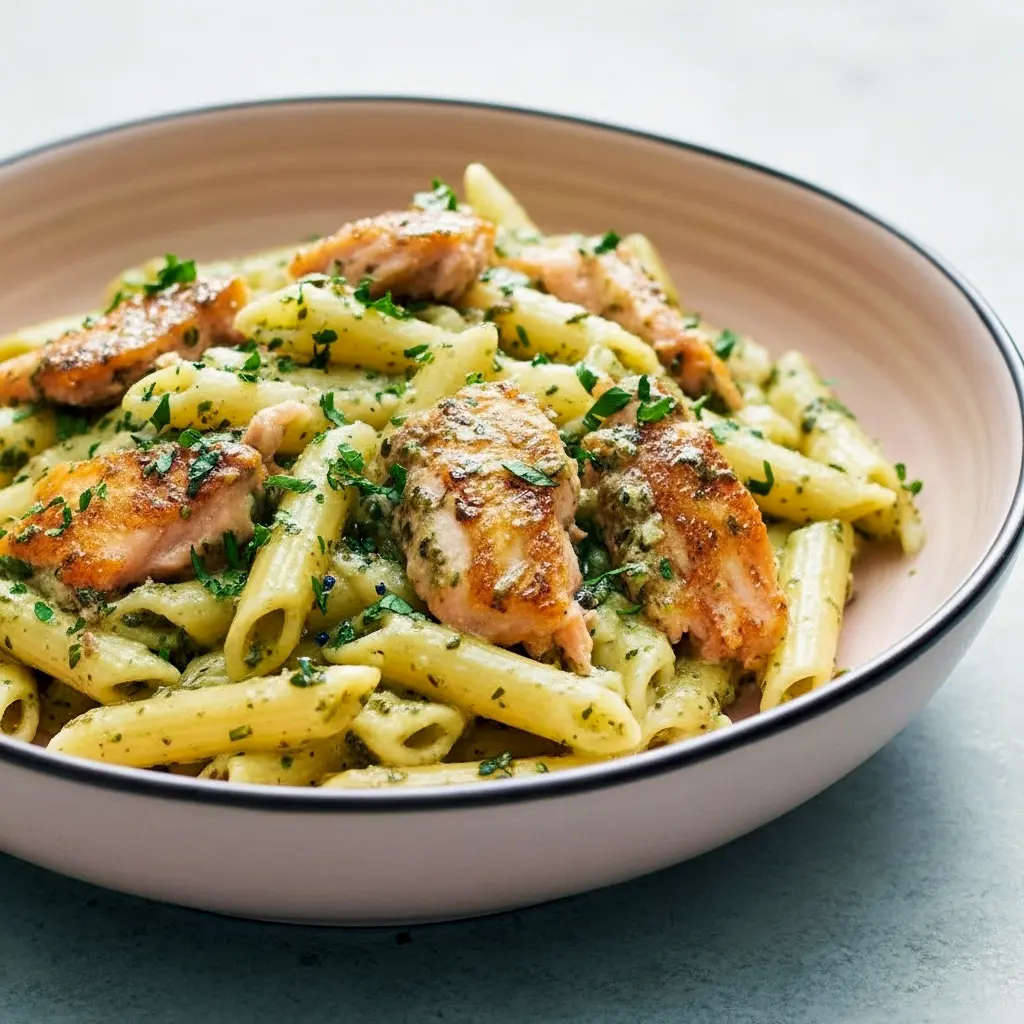Pesto Salmon Dish is my go-to for an effortless weeknight when I want something that feels fancy but takes almost no time. Pan-seared salmon, a silky pesto-cream sauce, and your favorite pasta — done in about 30 minutes. Ready? Let’s make dinner feel like a cheat-code.
Introduction — quick, elegant, and surprisingly simple
This Pesto Salmon Dish is fast, bright, and gorgeous on the plate. Use jarred pesto to save time or make your own if you’re feeling proud — either way, you’ll end up with a buttery sauce with a hint of lemon that plays perfectly with flaky salmon. Bold tip: A splash of cream mellows pesto and creates a sauce that clings to pasta beautifully.
What makes this Pesto Salmon Dish recipe so irresistible?
Why does this combo work every time? Texture and balance. Crisp, golden salmon skin or a light crust meets tender, flaky flesh. The pesto brings herbaceous punch; cream softens it and adds luxe body; lemon adds zip. You get savory, herby, bright, and rich in one forkful. Plus — it cooks fast. Who doesn’t want a dinner that looks restaurant-level without the fuss?
Bold tip: Don’t overcook the salmon. Sear until the outside is golden, then finish in the sauce briefly so it stays moist and flaky.
Ingredients — what you need and why it matters
- Pasta (penne, fusilli, or linguine): captures sauce; use what you love.
- Salmon (about 1 lb / 450 g): fresh fillets, skin on or off. Thicker fillets work best.
- Garlic powder + salt & pepper: simple seasoning for the fish.
- Flour (for light dredge): helps build a golden crust and slightly thickens the sauce.
- Olive oil + butter: oil for searing, butter for flavor and silky sauce.
- Chicken broth or dry white wine: adds savory depth.
- Pesto (jarred or homemade): the star flavor. Pick a brand you like.
- Heavy cream: a small splash makes the sauce luxurious and smooth.
- Lemon juice: balances the richness with bright acidity.
- Optional parmesan: for finishing, because cheese always helps.
Short descriptions: pasta = vehicle; salmon = protein + richness; pesto = herbaceous backbone; cream + lemon = balance.
How to make salmon pesto pasta — simple step-by-step
- Cook pasta. Boil salted water and cook the pasta until al dente. Reserve a cup of pasta water and drain.
- Season & dredge salmon. Pat fillets dry, season with salt, pepper, and a tiny sprinkle of garlic powder. Lightly coat both sides with flour. Shake off excess.
- Sear the salmon. Heat a skillet with oil + butter over medium-high heat. Sear salmon skin-side down (if using skin) until crisp, 3–4 minutes. Flip and cook 1–2 minutes — you want a nice crust but still a little rare inside. Remove to a plate.
- Make the sauce. Pour off some fat, leaving brown bits. Add broth (or wine) and scrape the pan. Stir in pesto, then pour in cream and lemon juice. Let bubble for 30–60 seconds to marry flavors.
- Finish the fish. Return salmon to the skillet and gently break it into large chunks. Let it warm in the sauce until cooked through.
- Combine with pasta. Toss drained pasta into the sauce, add reserved pasta water a splash at a time to loosen if needed. Plate, dust with parmesan, and serve.
Bold tip: Reserve pasta water — its starch helps the sauce emulsify and cling to pasta.
The story behind the dish
This Pesto Salmon Dish recipe came from wanting a quick, grown-up pasta that didn’t feel like takeout. Pesto and salmon naturally pair — the herbaceous basil cuts through the fish’s richness. Add cream and lemon, and you get a weeknight dish that tastes like you ordered it out. Readers have told me it “should be on a restaurant menu” — and honestly, I agree.
Pro tips for perfect results every time
- Use quality pesto. It’s the main flavor driver, so pick a brand you’d happily snack on.
- Pat salmon dry. Moisture = no crust; dry fillets sear better.
- Moderate heat. Too hot and you’ll burn garlic notes; too cool and salmon won’t crisp. Find medium-high where your pan gets a good sizzle.
- Don’t skip the lemon. Acid brightens the sauce and prevents it from feeling heavy.
- Toss gently. Break the salmon into chunks instead of shredding; it keeps texture and looks better on the plate.
Bold tip: If using salmon with skin, sear skin-side down first and don’t flip until the skin releases easily.
Variations to try — keep it fresh every time
- Dinner party upgrade: Finish with a drizzle of good olive oil and a handful of toasted pine nuts.
- Vegetable boost: Add blanched asparagus tips, peas, or sautéed zucchini when you toss in the pasta.
- Fried fish twist: Pan-fry the salmon more fully for a crisper texture — this nods to Fried Fish And Pasta Recipes.
- Wine swap: Replace chicken broth with a splash of Sauvignon Blanc for extra depth.
- Cream-free option: Skip cream and add extra pesto + a touch of pasta water for a lighter sauce if you prefer.
Best way to serve — pairing ideas that actually work
This dish stands on its own with a simple salad and crusty bread. Try:
- Simple arugula salad with lemon vinaigrette (refreshing and peppery).
- Garlic bread or crusty baguette to soak up sauce.
- Light sides like roasted tomatoes or a green bean almondine.
Serve immediately while the salmon remains tender and the sauce glossy.
Bold serving tip: Finish with grated parmesan and a squeeze of lemon for a bright, salty finish.
Quick tips for storage and leftovers
- Fridge: Store in an airtight container for 2–3 days. The fish softens with time, so reheat gently.
- Reheat: Warm on low in a skillet with a splash of cream or broth to revive the sauce. Microwave in short bursts if needed.
- Do not freeze assembled salmon pasta — the texture of the fish and sauce will degrade. If you must freeze, freeze salmon and pesto separately from pasta.
Bold tip: Add a splash of reserved pasta water when reheating — it brings the sauce back to life.

FAQs — everything you might ask
Can I use frozen salmon?
Yes — thaw completely, pat dry, and proceed. Frozen fish releases more moisture, so drying is crucial.
What if I don’t want cream?
You can omit it and use extra pesto plus a little pasta water. The sauce will be lighter but still tasty.
Which pasta to choose?
Short shapes like penne or fusilli trap sauce well; long shapes like linguine are classic and elegant.
Is this recipe pescatarian-friendly?
Absolutely — it’s a perfect Pescatarian Pasta or Easy Pescatarian Meals For Dinner option.
Can I use jarred pesto?
Yes — a good jarred pesto works great and keeps this a true quick dinner.
Pairing it with other dinner ideas
Looking for Dinner Recipes For Family Salmon that please diverse palates? This dish balances sophistication and comfort. Serve it alongside simple roasted vegetables or a kid-friendly side like buttered peas. Want a fancy touch? Add lemon-herb ricotta dollops on the plated pasta.
Quick substitutions & accessibility swaps
- No seafood? Substitute with grilled chicken or roasted cauliflower for a vegetarian-friendly twist.
- Dairy-free: Use a splash of full-fat coconut milk (flavor changes) or skip cream.
- Low effort: Roast salmon in the oven while you make the sauce — less pan work, same result.
Final thoughts — why this earns a regular spot on the menu
This Pesto Salmon Dish hits the sweet spot between fast and impressive. It’s a reliable Pesto Pasta Dinner Idea that works for weeknights, date nights, or when you want something a little special without the stress. The recipe adapts easily: swap pasta shapes, add veggies, or try a white wine base for a twist. Want a fuss-free, crowd-pleasing dinner that still feels intentional? This is it.
Bold takeaway: Fast, elegant, and flexible — salmon + pesto + cream = comfort with class. Now go make dinner that wows in 20 minutes.
Follow me on Pinterest for daily new recipes.
Print
Ultimate Pesto Salmon Dish — Irresistible 20-Min Dinner
- Prep Time: 10 minutes
- Cook Time: 20 minutes
- Total Time: 30 minutes
- Yield: 4 servings 1x
- Category: Dinner
Description
A speedy, elegant dinner: seared salmon folded into a creamy pesto sauce and tossed with pasta. Use a jar of pesto for convenience or your own homemade batch.
Ingredients
- 8 oz (about 225 g) dry pasta
- 1 lb (≈450 g) fresh salmon fillet
- Salt and freshly ground pepper, to taste
- 1/4 tsp garlic powder
- Plain flour, for dusting
- 1 Tbsp olive oil
- 1 Tbsp butter
- 1/3 cup (about 80 ml) chicken stock or a dry white wine
- 1/3 cup (about 80 ml) basil pesto (store-bought or homemade)
- 1/4 cup (60 ml) heavy cream
- 1/2 tsp lemon juice (optional — see note)
- Freshly grated Parmesan, for serving (optional)
Instructions
- Bring a large pot of salted water to a boil and cook the pasta until just firm to the bite according to the package; drain and set aside, reserving a little pasta water if needed.
- Season the salmon on both sides with salt, pepper, and garlic powder. Lightly coat the fillet with flour, shaking off any excess.
- Warm the olive oil and butter in a skillet over medium-high heat. Sear the salmon 3–4 minutes per side, until a golden crust forms. Transfer the fish to a plate and set aside. Pour off most of the fat from the pan but leave the browned bits stuck to the bottom.
- Return the pan to the heat and add the chicken stock (or wine), scraping the pan to loosen the fond. Stir in the pesto and let the mixture warm for about 30 seconds.
- Add the cream and lemon juice, bring to a gentle simmer for about a minute. Return the salmon to the skillet and use a spoon to flake it into large, chunky pieces. Reduce the heat and simmer a few minutes more until the salmon is cooked through and the sauce thickens slightly.
- Toss the drained pasta with the sauce, combining gently so the salmon stays in chunks. Add a splash of reserved pasta water if you want a looser sauce.
- Serve immediately, topped with grated Parmesan if you like.
Notes
- Heavy cream gives the sauce its silky texture; milk or half-and-half can separate and aren’t recommended. If you must skip cream, omit it and add a little extra pesto and pasta water to bind the sauce.
- Some jarred pestos already contain lemon — taste before you add more citrus.
- If your salmon has skin you don’t want to eat, it’s easy to peel it away after searing and moving the fillet to a plate.
- Leftovers keep in the fridge for 1–2 days; reheat gently over low heat with a splash of broth or cream.
Nutrition
- Calories: 567kcal
- Sugar: 2g
- Sodium: 349mg
- Fat: 28g
- Saturated Fat: 8g
- Carbohydrates: 46g
- Fiber: 2g
- Protein: 32g
- Cholesterol: 92mg



